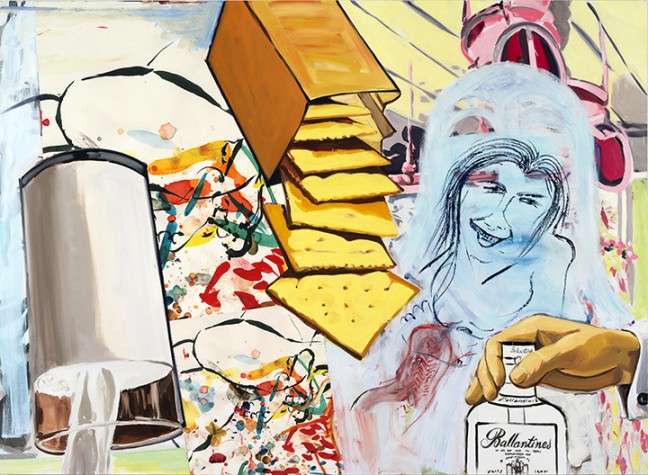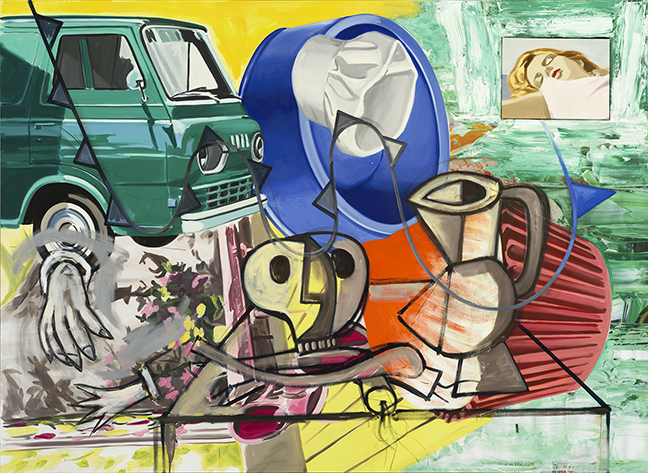The first thing I noticed when I walked into David Salle’s studio in Downtown Brooklyn were his brushes. There were so many of them—big ones, small ones, long ones, short ones, skinny ones, chubby ones, fat ones. Wood stained handles, in vintage looking coffee cans of various sizes, leaning against one another like lovers, tips a rainbow of colors.
Heralded “the worst painter in America” by Hilton Kramer, the once infamous lead art critic for the New York Times, Salle is now widely considered one of the major American painters of the past 40 years, responsible for, amongst other things, redefining neo-expressionism (For the record, Kramer said the same thing about Roy Lichtenstein.) Though Salle grew up and attended an art school in the middle of the “prairie land” of Wichita, Kansas, he had marvelous teachers whom he still remembers fondly as “an older couple named Bill and Betty Dickerson.” Coming to New York City was a thrill, he remembers. But it was also a mandatory move that would require great dedication and a life of poverty.
“It was always clear in those days that to pursue a serious career as a painter, one had to be in New York City,” he told me, as we sat down for a chat. “It was an article of faith in the years when I just starting out that no one would have any money, that survival would be hard scrabble at best, that there was a community of peers and colleagues that supported one another and that is what got people through.”
Salle can (and does) explain his art in the simplest terms possible: “My work is about putting things together.” But one doesn’t need Salle to understand that. It’s the rest of him that’s fascinating to me. What do you first think when you wake up in the morning? How do you drink your coffee? What clothes do you paint in? Do you stretch your own canvases? Do you know how to stretch a canvas?

Most of all, I was fascinated by those brushes. I imagined them coming to life in some sort of Mannequin-esque movie, fighting amongst each other, vying to be the one used to make his next masterpiece. David, use me!
I had so many questions: Where do you get them? Do you use all of them? Do you enjoy buying them? Are you constantly on the hunt for the perfect one? How do you decide which one to use?
David, who is quite reserved to begin with, seemed genuinely perplexed by my fascination—it was clear no one had ever interrogated him about his brushes before. He looked at me almost pityingly. “Don’t you want to ask me about art criticism?”
Now it was my turn to be taken aback. I was like, Why would I want to ask you about art criticism? Everyone asks you about art criticism. If I wanted to know about art criticism, I would just Google your name followed by the words “art” and “criticism.”
“Fair enough,” said Salle, “I suppose it’s not that interesting, anyway.”
But these brushes, tho. They’re uh-mazing. I felt myself getting angry. You don’t even think about them, do you? David looked around his studio, nodding. I’ve never thought about it, but I guess there really are. And then, he looked at me again, realizing that relatively speaking, this was possibly the stupidest question anyone could ask him.

Paintings are made with a brush, he said.
I was clearly not going to budge.
Sighing, he acquiesced. There is a famous art store in Rome (of course it would have to be in Italy) called Poggi. It is the place to go for brushes. The owner Mimeo, makes them by hand.
You didn’t think he was making those masterpieces with some piece of junk made in China, did you?
By the way, David Salle has the most incredible hands I have ever seen. And, of course, some serious style. Other than talent (which should be obvious) painting is really about style. He takes his coffee with milk and a little sugar. He wears his regular clothes, which then get covered in paint and become his painting clothes.
I came away from our meeting thinking about some of the more interesting things he said, like the idea that the discourse of art has become totally focused on intentionality and is divorced from human agency. That premium is put on content rather than form. That there is a de-emphasis on the fact that this is something that someone has actually made. And that because it’s true that someone has actually made these things, it’s kind of thrilling to know a little more about that person.
Which is why my interest in David Salle’s brushes maybe isn’t so trivial after all.
Photos courtesy of David Salle Studio




